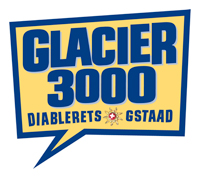
































Olivier Mosset
Toblerone, 2003-2014
Toblerones - the colloquial name for the anti-tank roadblocks that were built between 1939 and 1945 to protect Switzerland from foreign invasion – are one of conceptual painter Olivier Mosset’s few sculptural forms. First executed in cardboard, they are here made out of ice. Marking not just the frontier of the town but also the high point of the glacier, they stand sentinel to forces unknown.
2. Car park Saanendorf, Saanen

Olivier Mosset was born 1944 in Bern, Switzerland and lives in Tucson, Arizona. For the last four decades, he has remained committed to questioning painting as a historical object by, somewhat paradoxically, continuing to paint. Through his affiliation with the B.M.P.T., a group of conceptually driven painters formed in Paris in the 1960s, Mosset and his peers—Daniel Buren, Michel Parmentier, and Niele Toroni (their initials reflected in their collective acronym)—sought to democratize art through radical procedures of deskilling. They also deftly deconstructed such modernist shibboleths as the primacy of authorship and the value of originality by signing each other’s works and repeating a specific compositional device across multiple grounds: while Buren became well-known for keeping to stripes, Mosset focused on the circle, which he painted in some two hundred iterations between 1966 and 1974.
Since that time, Mosset has turned to monochrome works on shaped canvases that more or less implicitly comment on circuits of production and exchange (stars standing in for revolutionary aspirations, or dollar signs representing, well, dollar signs). He has also explored other formats and materials of abstract painting involving more traditional oil and acrylic, as well as industrial plastic. Mosset alternately culls forms from the landscape as found abstractions and anchors paintings back to it, site- and architecturally specifically: He drew from the antitank traps dotting Europe’s roadsides for the Toblerones (1994–2007), massive yet ephemeral Minimalism-inspired sculptures produced in ice. His shimmering Golden Shower (2007) transformed the lowered garage door of SculptureCenter in Queens, New York, into an improbably beautiful wash of yellow paint.


